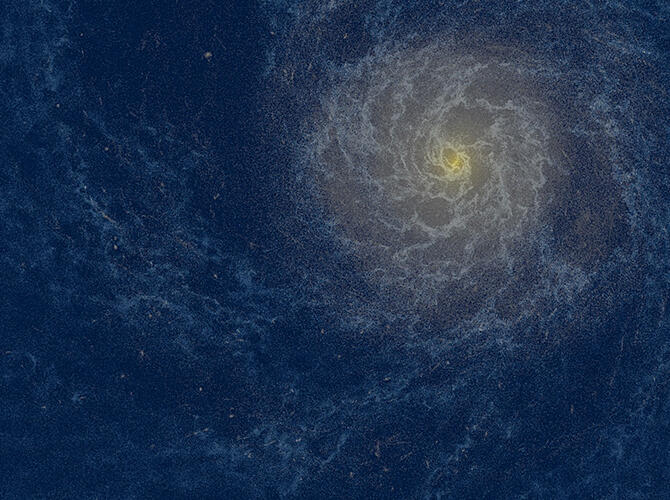A research group led by Research Fellow Yutaka Hirai of the Graduate School of Science, Tohoku University, in collaboration with the National Astronomical Observatory of Japan (NAOJ), the Joint Institute for Computational Fundamental Science, and Kobe University, has successfully simulated the formation of the Milky Way at the highest resolution in the world using ATERUI II, a supercomputer operated by NAOJ that is dedicated to astronomy. The simulation revealed that stars containing many precious elements heavier than iron, such as gold and platinum, were formed more than 10 billion years ago in smaller galaxies that served as the origin of the Milky Way. They also found that the elemental abundances and motions of the stars formed in the simulations are consistent with observations of stars in the Milky Way.

©Yutaka Hirai
Observations with the Subaru Telescope at the National Astronomical Observatory of Japan, and other telescopes, have confirmed that there are several stars in the Milky Way with a ratio of heavier-than-iron elements (gold, platinum, and other precious metals) to iron that is five times greater than that of the Sun. Gaia, a space observatory launched by Europe, has revealed that many of these stars have different orbits than the Sun. These features suggest that stars with an abundance of heavier-than-iron elements may have formed in a way that strongly reflects the formation history of the Milky Way, but it was not clear when and how these stars formed in the history of the galaxy.
The research group therefore simulated the formation of the Milky Way, from the birth of the universe 13.8 billion years ago, to the present. Their results show that most of the stars rich in noble elements heavier than iron formed more than 10 billion years ago in smaller galaxies from which the Milky Way was created. The simulation calculates how dark matter and gases gravitationally gather from the density irregularities in the early universe and how stars form in them.
The researchers achieved a resolution about 10 times higher than previous simulations by using ATERUI II and a numerical code they developed. This made it possible to spatially resolve the small galaxies from which the Milky Way was created, which could not be resolved before, and to explore how stars are born in these galaxies.
"It took us about seven years of repeated large-scale code development and testing to achieve the simulation results," commented Hirai. "In the future, we want to perform larger-scale simulations that can resolve even individual stars like the Sun. We would like to make full use of observations and simulations of stars in the Milky Way to understand the formation history of the galaxy over 13.8 billion years."
Journal Information
Publication: Monthly Notices of the Royal Astronomical Society
Title: Origin of highly r-process-enhanced stars in a cosmological zoom-in simulation of a Milky Way-like galaxy
DOI: 10.1093/mnras/stac2489
This article has been translated by JST with permission from The Science News Ltd. (https://sci-news.co.jp/). Unauthorized reproduction of the article and photographs is prohibited.




